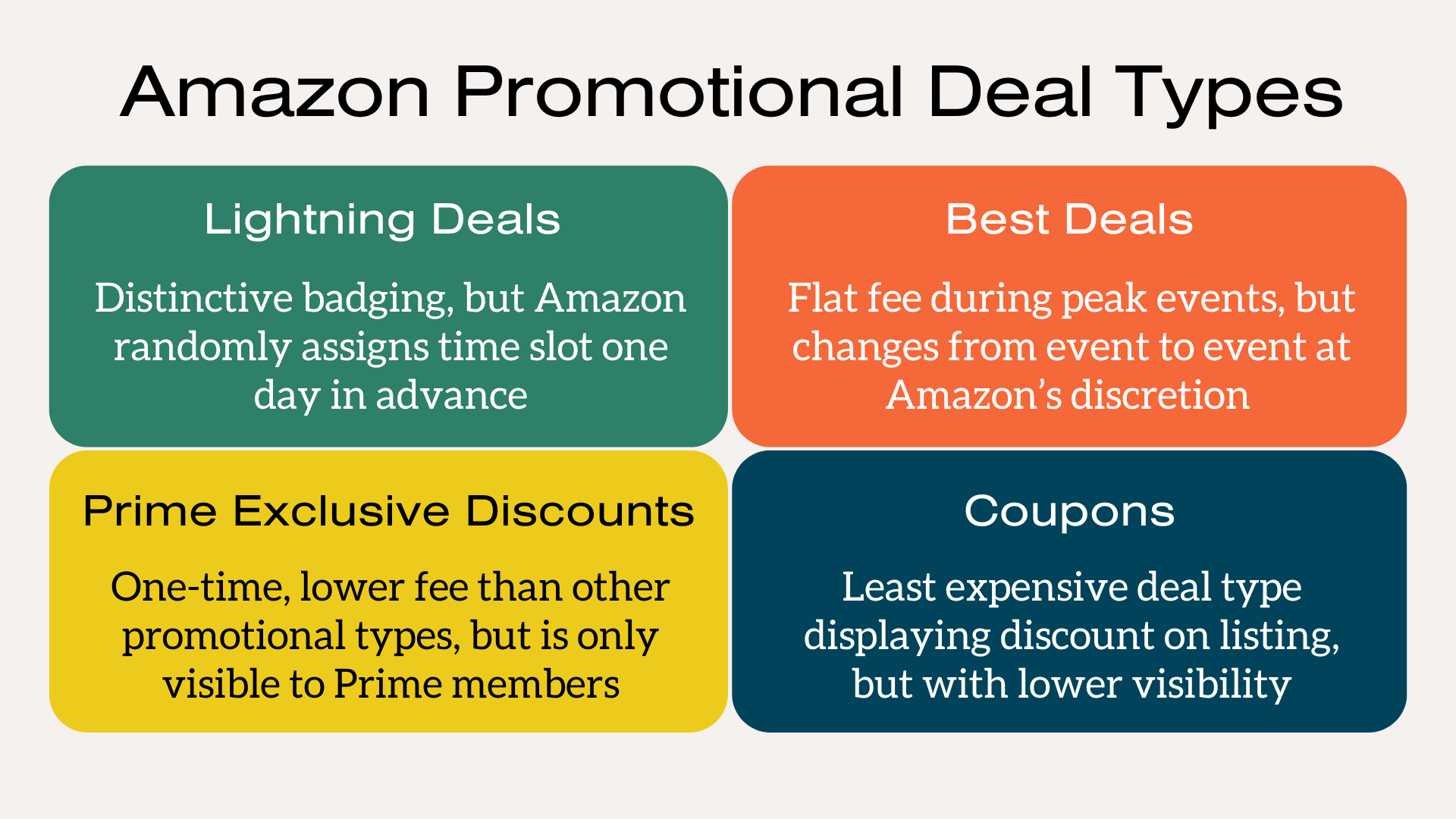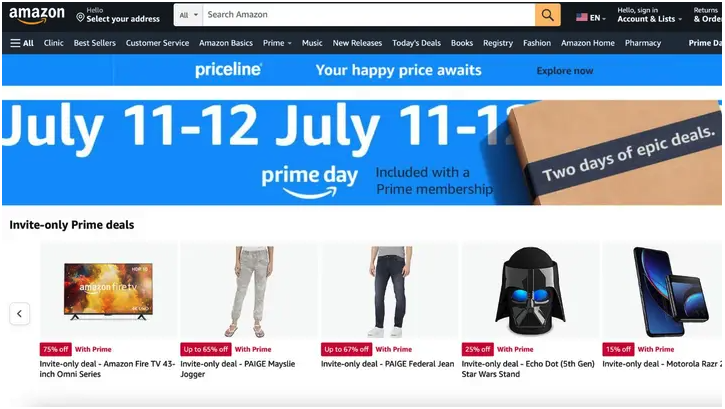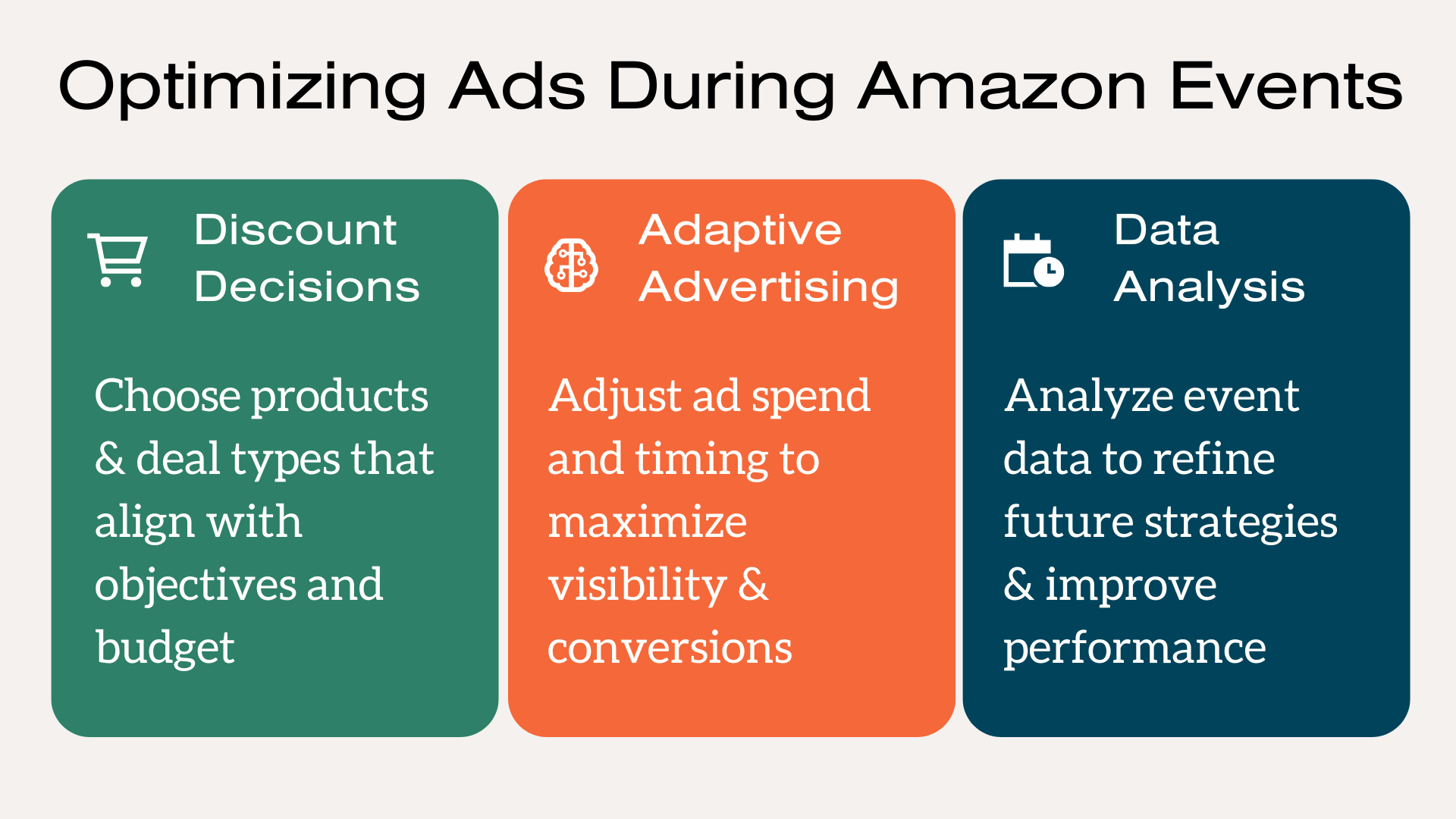If you have been managing Amazon marketing campaign strategies over the past few years, you have likely noticed that Prime Day, Black Friday, and Cyber Monday aren’t just big events – they’re getting bigger. Additional event days, new ad placement opportunities, and more competition cause each subsequent event to be more complex and costly. Without well thought out strategies and proper planning, you could find yourself walking away from these Amazon tentpole events with revenues that don’t justify the advertising invoice, while your competitors bask in their SOV (Share of Voice) gains. To stay ahead, you need to master three key areas:
- Product sales discount strategy
- Adaptive Amazon advertising strategies
- Acting on data
Tip #1: Everything Starts with Your Product Sales Discount Strategy
Before you touch your ad budgets, take a step back. The product sales discounts you offer are the foundation of your entire Amazon sales event advertising strategy.
Choose the Right Products
Start with your objective. Are you trying to drive more revenue? Push a new product into the spotlight? Liquidate stale inventory? Your product sales discount strategy should reflect those goals.
If you’re sitting on a mountain of inventory, your choices might lean toward aggressive product sales discounts. If it’s a new product with limited reviews, maybe you prioritize visibility and break even, or even lose a bit, to build up momentum.
Check your inventory levels, ensure the selected products are eligible for the types of promotions you plan on using, make sure your listings are retail ready with solid titles, bullet points, images, and reviews, and don’t forget to budget for both your Amazon sales discounts and ads strategy (these go hand in hand; a big price slash with no ad support means you’ll get buried and a huge ad push with no compelling offer means wasted spend).
Pick the Right Deal & Type of Promotion
The types of promotions offered around marketplace tentpole events are not created equal.
Lightning Deals: These give you a burst of traffic through distinctive badging and provide natural urgency for the shopper during the 6-hour window the deal is active for. They come with lower seller fees than Amazon coupons due to their limited run time, which only allows you to push them during specific hours of the day. For a multi-day tentpole event, you will need to keep bids low until the deals are active, at which point everything needs to be turned up to 11. Advertised Amazon ASINs within SP and SD marketing campaigns need to be altered, as well as an overhaul of your SB creative every time a product goes on sale. Moreover, it is likely that you won’t find out the timing windows that Amazon randomly assigns to your products until one day before. Our thoughts go out to you if Amazon decides to give you the 12am-6am time slot.
Best Deals: Discounts featuring Amazon Prime Day specific tagging and run on a day-to-day basis of your choosing during the event. Amazon has an upfront-fee structure where “peak days” require a flat seller fee and non-peak days are charged at a daily rate. The fee amounts also change for sellers from event to event at Amazon’s discretion.
Prime Exclusive Discounts: A less expensive option for sellers compared to Amazon Best Deals as they feature a one-time fee, regardless of the number of days ran during the event. The seller fee is also at a much lower rate than Amazon Lightning Deals or Best Deals. This, of course, comes at the cost of a smaller shopper base and less visibility as it will only be available to shoppers subscribed to Amazon Prime during the event.
Image via https://www.foxnews.com/tech/best-deals-amazon-prime-day-battle-plan-strategy-2023
Coupons: The least expensive option. Coupons show a sales discount badge on your product listing, but it will look different than the event specific badging. This tends to lead to lowered favorability towards both organic placements and paid advertising placements.
Overall, your choice should match your goals and your budget. And think about the sales percentage discount on your product; aim for a sweet spot. Too small and it won’t move the needle; too big and you’ll eat into your margins unnecessarily. If you can’t afford 20% off, don’t run a deal. The deadlines to submit deals are usually 45-60 days prior to an Amazon tentpole event, so you will need to plan ahead if you want to ensure the sales discount of your choice.
Timing Matters
The week prior to large sales events, many shoppers “window shop,” doing research for products they are interested in and would like to buy during the Amazon tentpole event. This is a great opportunity to gain detail page views that can then be retargeted via SD (Sponsored Display) marketing campaigns during the Amazon event, and it can also be an opportune time for conversions.
The week prior to Amazon tentpole events usually features lower CPC due to less competition and provides a chance to convert these window shoppers early if there is an active product discount running prior to an event.
Tip #2: Spend Wisely with Adaptive Amazon Advertising Strategies
Tentpole events are dynamic. Shopper behavior changes, competition heats up, and if your Amazon advertising strategy isn’t flexible, you’ll miss opportunities.
Budget Planning
Don’t just throw all of your budget at the wall and hope something sticks. Segment your spend intentionally across targeting types like generic keywords, branded terms, competitor targeting, and audience segments depending on your goal. Lean into generic and competitor terms for a growth focus or go all in on branded terms if you are looking to liquidate inventory or defend territory.
Balance your use of Sponsored Products, Sponsored Brands, Sponsored Display, and even DSP if that’s in your toolkit. Consider where each ad type fits in the customer journey. Amazon Sponsored Products are great for direct conversions, Sponsored Brands help build brand presence, and Sponsored Display and DSP are ideal strategies for remarketing and reaching new audiences.
Timing of Spend
Spending isn’t just about how much you invest, it’s about when you spend it. Use a wave approach. Start with pre-event marketing campaigns to drive early traffic and add-to-carts on Amazon. During the event itself, ramp up spend on your top performers. After the event, retarget shoppers who browsed but didn’t convert.
Be ready to adjust mid-event based on real-time performance. The advertisers who monitor closely and pivot quickly usually come out ahead.
Tip #3: Use All That New Data to Improve Your Amazon Advertising Strategy
During tentpole events, you’ll generate a ton of data. Don’t let it sit there. Analyze key Amazon performance marketing metrics, learn from them, and use them to get better for your next Amazon marketing campaign.
Data Periods
First, choose the right window for analysis. Don’t just look at event days. Include the lead-up and the days after to get the full picture of shopper behavior.
Compare performance Period-over-Period if you’re evaluating against a previous event, or Year-over-Year if you want to understand longer-term growth. If you’ve run similar events in the past, use key Amazon performance marketing metrics from them as benchmarks to set expectations for this one.
Focus on Key Amazon Performance Marketing Metrics
Go beyond surface-level Amazon performance marketing metrics and dig into what’s key for moving the needle:
- T-ACOS helps you understand how ad spend is pushing Total Revenue
- NTB (New To Brand) Orders show if you’re attracting new customers
- AOV helps you evaluate basket size and upsell success
- CVR and CTR give insight into how compelling your listings and ads strategy are
Tracking these key Amazon performance marketing metrics gives you a much more complete picture than just looking at ROAS.
Don’t Let the Data Go to Waste
Insights are only valuable if you act on them. If a product underperformed, think about swapping it for a different one during future tentpole events. If a specific audience segment or targeting tactic worked well, double down.
Create new lookalike audiences based on your event converters. Retarget cart abandoners and page viewers who didn’t convert. Update your creative and refine your deal offers based on what resonated. Harvest new keywords from broad match or auto campaign queries that converted at a high rate.
Each event is a learning opportunity, so treat your data like gold.
Final Thoughts
Amazon tentpole events aren’t what they used to be. They’re longer, more crowded, and more expensive to participate in. But that also means more potential upside if you’re strategic.
Leverage a smart sales discount strategy, build adaptive Amazon advertising strategies, and act on your data after the dust settles. Follow these tips and you’ll not only survive the next sales event, but you might also crush it.




